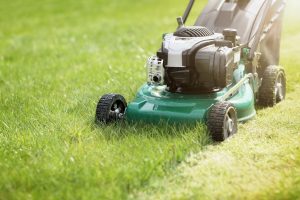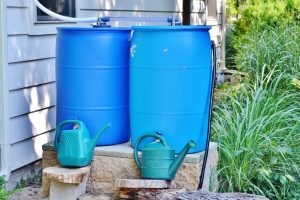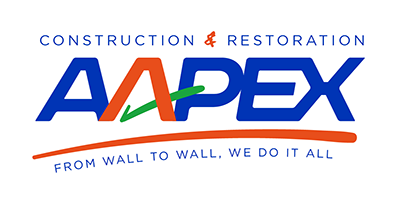Anytime the sky turns grey, homeowners with basement flooding issues often keep an anxious eye trained on their basements for the first signs of water intrusion. While there are many reasons a home may have water in the basement, one of the most prevalent is landscaping that directs water toward, rather than away, from the foundation. Keeping water away from your home is the simplest solution for avoiding water intrusion. Follow these tips for landscaping around your home to help prevent your basement from flooding.
Use Grading to Direct Water Away from the Foundation

Proper grading is important in keeping water away from your home’s foundation. In fact, this is such an important factor that it is included in point-of-sale home inspections. Improper grading allows water to collect near the foundation, putting added pressure on the foundation walls until a crack or leak is created that allows intrusion. A good guideline for maintaining proper foundation grading is to have a slope of 6 inches for the first 10 feet around all foundation walls. Grading near the house is important for maintaining healthy foundation walls, but equally as important is grading your property so that water is directed away from your house. If your yard is draining in such a way that allows water to pool near your home, landscaping to direct that water around and away from your home will go a long way in helping prevent your basement from flooding. Before modifying your property’s grade, be sure to contact your city’s building engineer. In many cases, the grade of your property is designed to direct rainwaters toward storm sewers. Interfering with this grading may affect your neighbors or even make your flooding issues worse.
Landscape with Native Plants

Landscaping with native plants is not only ecologically friendly, but native plants are far better suited for handling our climate than exotic, sometimes invasive, plants. Native plants have spent
thousands of years evolving to become perfectly suited for this environment. Northeast Ohio’s local plants thrive in the wet spring, scorching summer heat, and heavy autumn flooding rains. They are also able to survive the frigid lows we face each winter, coming back even stronger in the spring. Native plants help prevent soil erosion because they do not require extra watering to survive the summer heat. Local plants further reduce flooding and drainage issues by helping filter storm water runoff.
Mulch to Prevent Basement Flooding
Mulch is used in landscaping to help moderate soil temperature and moisture levels, prevent weeds, and keep garden beds looking

pretty. It provides a moisture wicking layer of insulation that prevents soil from drying out or being washed away during heavy rains. Its ability to hold onto moisture makes it very helpful in controlling water flow and preventing basement flooding. Lay mulch in garden beds away from your house to help direct the flow of rainwater away from your home. If you mulch in the garden beds next to your foundation, be sure to keep a 4-6 inch barrier between your foundation walls a
nd your mulch. Because mulch retains moisture, placing mulch directly next to your home’s foundation would be like putting a wet sponge around the perimeter of your home. This can lead to cracks in your foundation as well as water damage to your home’s structure.
Landscape with Turfgrass Suited for NE Ohio’s Climate

A yard with a healthy lawn will be much better at absorbing heavy rainfalls and keeping the water away from your home’s foundation (and out of your basement). However, some of the most popular turfgrasses, like Kentucky Bluegrass, require extensive upkeep to keep them thriving in our climate. By the time our mid-summer scorch sets in, these high maintenance turfgrasses will have gone dormant, making them useless against the late summer torrential downpours that are standard for Northeast Ohio. We recommend seeding with a turfgrass blend that will be better suited for thriving in our climate. Be sure to keep your grass on the longer side, which helps promote a healthy root structure and actually “shades out” many of the pesky weeds that like to invade our lawns.
Install a Rain Garden
 Lush with tall grass, native wildflowers and shrubs, rain gardens are designed to catch and quickly absorb heavy rainfalls. Typically planted in shallow, landscaped depressions where rainwater tends to accumulate, properly designed rain gardens will absorb rainfall within a day. This not only helps manage floodwaters around your home, but it also prevents the accumulation of standing water that would become a breeding ground for mosquitoes. Using grading, garden beds, and even downspouts, you can direct rainfall from your home to the rain garden. Nature will take care of the rest. Rain gardens also give a boost to our environment by providing the perfect habitat and food for butterflies, hummingbirds, and pollinators.
Lush with tall grass, native wildflowers and shrubs, rain gardens are designed to catch and quickly absorb heavy rainfalls. Typically planted in shallow, landscaped depressions where rainwater tends to accumulate, properly designed rain gardens will absorb rainfall within a day. This not only helps manage floodwaters around your home, but it also prevents the accumulation of standing water that would become a breeding ground for mosquitoes. Using grading, garden beds, and even downspouts, you can direct rainfall from your home to the rain garden. Nature will take care of the rest. Rain gardens also give a boost to our environment by providing the perfect habitat and food for butterflies, hummingbirds, and pollinators.
Prevent Basement Flooding with Rain Barrels

Placed at the bottom of your home’s downspouts, rain barrels collect rainwater runoff from the roof, keeping water away from your foundation and protecting your basement from flooding. They are also an eco-friendly way to source irrigation water for your gardens and lawn. Be sure to install an overflow port connected to a hose that will shed the water at least 6 feet away from the foundation. You may also opt for a rain barrel diverter, which will divert water from the downspouts into the rain barrel until it is full and then channel it back through the downspouts.
If your basement has flooded, and especially if it habitually floods, be sure to keep ahead of any water damage or mold growth that may be settling in. Aapex Construction & Restoration has more than 20 years of experience with a team that is exceptional in both workmanship and customer service. We specialize in insurance and non-insurance restoration projects, both for commercial and residential properties. Contact us today to schedule your consultation.
Related Articles
Water in Your Basement: Sources and Solutions
The Importance of Gutter Cleaning


